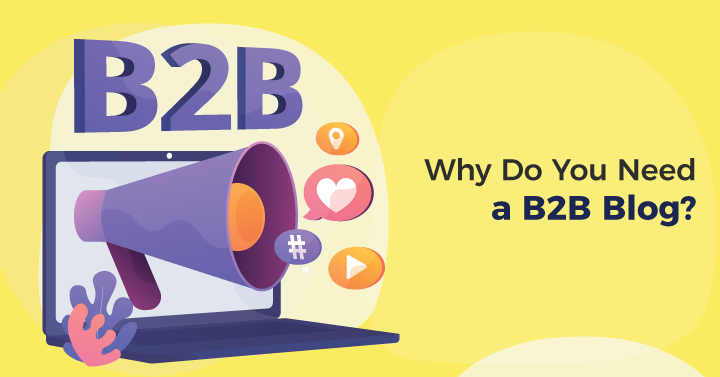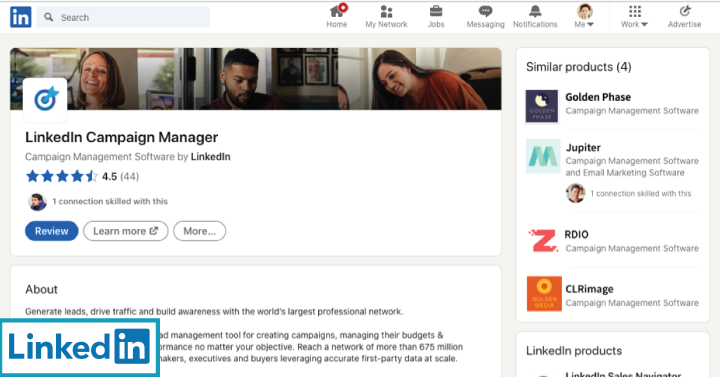In the digital landscape where a whopping 8.28 million blog posts surface daily, crafting B2B blog content that truly resonates and drives results can be a daunting task. Fortunately, some B2B blogs stand out as strategic assets, delivering tangible business results.
These B2B blogs meticulously pinpoint target audiences, identify high-value topics, and adhere to consistent publishing schedules. This helps them cultivate loyal followings and amplify their reach through strategic social engagement.
In this article, we’ll showcase 10 B2B blog examples that will help you elevate your content marketing strategy and captivate, convert, and connect with your audience effectively.
2. What Is a B2B Blog?
A B2B blog, or business-to-business blog, is created and published by a business for other businesses. Unlike a B2C (business-to-consumer) blog, which is intended for a wider audience, a B2B blog is focused on sharing information, insights, and knowledge relevant to other businesses. The primary goal of a B2B blog is to educate and inform other companies about industry trends, best practices, case studies, practical tips, news relevant to their operations.
B2B blogs serve multiple purposes. They help businesses establish themselves as industry leaders, build trust with potential clients, and generate qualified leads. A B2B blog covers various topics, depending on the business’s industry and target audience.
For example, a software company might create a B2B blog covering topics such as software development best practices, industry trends in software development, and tips for effectively using their specific software products. B2B blog examples can be a valuable resource for businesses looking to improve their content marketing strategy.
3. Why Do You Need a B2B Blog?

- Thought Leadership
B2B blogs are effective tools to showcase your thought leadership and expertise in your industry. By sharing your expertise and insights through your blog posts, you can demonstrate your authority and credibility to potential customers, building trust and confidence in your brand. This can lead to increased traffic as people seek out your blog for insights and information and can also result in more inbound links to your website from other authoritative sources in your industry, further boosting your search engine rankings.
- Increased Website Traffic
B2B blogs are a great way to drive website traffic and increase visibility for your business. By consistently publishing high-quality, informative content on your blog, you can attract potential customers to your website who are interested in the products or services you offer. One way B2B blogs drive traffic is through Search Engine Optimization (SEO). By incorporating relevant keywords and phrases into your blog posts, you can improve your website’s ranking in search engine results pages (SERPs).
- Relationship Building
B2B blogs are also a great way to build relationships with your audience. You can engage with your audience and build a community around your brand through your blog. This creates an opportunity for two-way communication, where you can respond to your audience’s questions and concerns and gain insights into your audience’s needs and preferences. Building relationships with your audience through B2B blogs can also help increase social media engagement. When you share your blog content on social media, you can encourage your followers to share, comment, and like their posts.
- Increased Brand Awareness
B2B blogs can be a valuable tool for increasing brand awareness by creating shareable and easily discoverable content. You can increase the chances that people will engage with and share your content, further amplifying your brand’s message. By creating shareable, valuable, and informative content, you can expand their reach and visibility, ultimately leading to more leads and sales.
- Competitive Advantage
An influential B2B blog can also give you a competitive advantage over other businesses in your industry. The content you curate on your blog sets you apart from your competitors, and you can establish your brand as a leader in your space. It also helps you attract and retain top talent. You can showcase your expertise in your blog and demonstrate to potential employees that you are offering opportunities for growth and development. This can attract top talent and retain existing employees who want to work for a business that values innovation and expertise.
- Cost-Effective Marketing
B2B blogs are a cost-effective way to market your business. Unlike traditional advertising, which can be expensive and difficult to measure, a blog can be created and maintained with minimal investment. This makes it an excellent option for businesses of all sizes and budgets. In addition, with tools like Google Analytics, you can track the number of visitors to your blog, where those visitors are coming from, and what they are reading. This data can be used to measure the effectiveness of a marketing campaign and make adjustments as needed.
4. Top Ten B2B Blog Examples
To help you gain inspiration and insight into how successful B2B blogs can be, here are ten exceptional examples:
Hubspot
Hubspot is a marketing, sales, and customer service software company offering a suite of business tools. Their software includes CRM, marketing automation, sales automation, and customer service tools. They also provide a range of free resources, such as B2B blog templates, courses, and tools, to help businesses improve their inbound marketing efforts.
What makes their blog unique?
If you’re looking for great B2B blog topics about marketing, sales, and customer service, you should check out Hubspot Blog. They have really interesting and informative posts that we think you’ll love. The visuals they use are awesome too, and they help break up the text nicely. And here’s something cool – they end each post with a strong call to action that encourages readers to sign up for their services. You’ll definitely learn something new from their well-written blog posts. And they even provide actionable tips to help you improve your marketing and sales strategies.
Pros:
- The blogs are optimised for search engines, making it easier for businesses to improve their search engine rankings and attract more traffic to their blogs.
- It comes with various analytics and reporting tools, providing businesses with valuable insights into their blog’s performance.
- The platform offers features like content planning, content creation, editing, and publishing workflows.
Cons:
- Some blog posts are too long for readers with short attention spans.
Buffer
Buffer is a social media management platform that allows businesses to schedule, publish, and analyse their social media content across multiple platforms. They also offer a range of features to help companies to engage with their audience on social media, such as social listening and analytics. Buffer’s platform is user-friendly and designed to help businesses save time and improve their social media presence.
What makes their blog unique?
Buffer’s blog covers many topics related to social media marketing and content marketing, and their content is really top-notch. You’ll find practical advice and insights that can help you improve your social media presence, and they present everything in a conversational writing style that’s easy to read and engaging. Plus, the writers use real-world examples and anecdotes to illustrate their points, making the content more relatable. And that’s not all! Buffer offers many other valuable resources, like eBooks, webinars, and templates, designed to help you up your social media marketing game.
Pros:
- It has an active community of readers who engage with the content by commenting, sharing, and providing feedback.
- The writers are open and honest about their experiences and challenges, making the content more relatable and trustworthy.
Cons:
- Some blog posts are too technical for readers with little social media marketing experience.
Salesforce

Salesforce is a cloud-based CRM software company that helps businesses manage customer relationships. Their software includes features such as sales automation, marketing automation, customer service, and analytics. They also offer a range of integrations and third-party apps to help businesses customise their CRM to their specific needs.
What makes their blog unique?
Salesforce B2B blog covers various topics related to sales, marketing, customer service, and technology, providing readers with valuable insights and strategies for success. You’ll find tonnes of valuable insights and strategies for success. Plus, they have a bunch of different content formats to choose from, like articles, whitepapers, eBooks, webinars, and podcasts, so you can learn and engage with the content in the way that works best for you. And the blog itself is designed with you in mind, featuring a clean and intuitive interface that makes it super easy to navigate and find the content you need. And one more thing – their blogs are mobile-responsive, so you can access them on the go.
Pros:
- Covers a wide range of topics with extensive research and well-written.
- You can see different content formats that engage the audience at various stages of the sales funnel.
Cons:
- The content can be technical and focused on the needs of enterprise-level businesses, which may not be relevant for smaller companies or those just starting.
- With new articles published daily, keeping up with the latest insights and information can be challenging.
Moz
Moz is an SEO software company that offers tools to help businesses improve their website’s search engine rankings. Their software includes features such as keyword research, link building, and site audits. They also offer a range of resources, such as a blog and community forum, to help businesses stay up-to-date on the latest SEO trends and best practices.
What makes their blog unique?
If you’re looking to boost your online game, the Moz blog is definitely worth checking out. It’s an awesome resource for businesses looking to up their online presence. They’ve got a bunch of SEO information and insights that are super helpful. The Moz blog is written by industry experts and thought leaders, so you can trust that you’re getting valuable insights and strategies for improving your search engine optimisation (SEO) and digital marketing efforts. They cover a wide range of SEO-related topics, like keyword research, link building, and content marketing.
Pros:
- The blog offers practical and actionable advice that businesses can implement immediately to improve their online presence.
- It acts as a step-by-step guide that makes it easy for readers to follow and implement the strategies.
Cons:
- The Moz blog can be very technical and jargon-heavy, making it difficult for beginners to understand some concepts.
- Moz’s blog offers a lot of valuable information on SEO, but it can be limited in scope. Businesses looking for information on other areas of digital marketing, such as social media or email marketing, may need to look elsewhere for resources.
Marketo
Marketo is a marketing automation software company that offers a range of tools to help businesses streamline their lead generation and nurturing processes. Their software includes features such as email marketing, lead scoring, and analytics. They also offer integrations with other software, such as Salesforce, to help businesses create a seamless sales and marketing process.
What makes their blog unique?
The Marketo blog has unique content that’s super actionable for B2B marketers specifically. The blog is all about providing insights into the challenges and opportunities that B2B marketers face, which really sets it apart from other marketing blogs. And don’t worry about your industry or niche – they cover a wide range of topics, so you’ll definitely find something relevant. Whether you are a beginner or an experienced marketer, you will find it a valuable resource.
Pros:
- The Marketo blog is designed explicitly for B2B marketers, meaning the content is tailored to the unique challenges and opportunities that B2B marketers face.
- The content is based on the latest trends and research in the marketing industry.
Cons:
- Marketo heavily promotes its products and services on the blog.
- It lacks diversity as other marketing blogs.
LinkedIn Marketing

LinkedIn Marketing is a suite of tools and services that allow businesses to use LinkedIn for marketing purposes. Their offerings include sponsored content, sponsored InMail, and dynamic ads. They also offer a range of resources, such as a blog and webinars, to help businesses optimise their LinkedIn marketing efforts.
What makes their blog unique?
The LinkedIn Marketing blog is all about marketing, specifically on LinkedIn, so you know the content is going to be super relevant to your B2B marketing efforts. They really focus on the unique features and opportunities that LinkedIn offers, which means you’ll get more targeted insights and strategies. And the best part? They provide data-driven insights into the behaviour and preferences of LinkedIn users, so you can be sure you’re making informed decisions. They even back up their insights with research studies and reports, which adds even more credibility.
Pros:
- The content gives insights into the features and opportunities LinkedIn offers for B2B marketers.
- It provides data-driven insights into the behaviour and preferences of LinkedIn users.
- The LinkedIn blog encourages community engagement through comments and social sharing.
Cons:
- There are certain subjects that are not covered as in-depth as readers would like.
- The blog heavily promotes its products and services.
Kissmetrics
Kissmetrics is an analytics software company that helps businesses track and analyse user behaviour on their website or mobile app. Their software includes features such as user segmentation, cohort analysis, and A/B testing. They also offer resources such as blogs and webinars to help businesses improve their marketing and user experience.
What makes their blog unique?
If you’re looking for data-driven insights and analytics to improve your business, the Kissmetrics blog is a great resource. The blog strongly focuses on understanding your customers’ journey and using data to optimise it. Plus, the blog offers practical tips on how to apply these insights to your marketing strategies, so you can start seeing results right away. By putting your customers at the centre of your marketing efforts, you can increase customer retention rates and boost revenue.
Pros:
- The Kissmetrics blog provides detailed tutorials and guides that help businesses get the most out of their marketing analytics tools.
Cons:
- It may not be the best resource for businesses looking for more creative or storytelling-focused marketing strategies.
- Some of the tutorials and guides provided by Kissmetrics are more advanced and technical.
Neil Patel
Neil Patel is a digital marketing consultant and speaker who offers a range of marketing services and resources. His services include SEO, content marketing, and social media marketing. He also provides free resources, such as a blog, podcast, and courses, to help businesses improve their digital marketing efforts.
What makes their blog unique?
Neil Patel’s Digital Marketing Blog is based on his extensive experience and expertise in digital marketing. You will find various free tools and resources on his website, such as SEO analysis and performance tracking. These tools and resources are valuable to businesses looking to improve their marketing strategies and set their blogs apart.
Pros:
- Neil Patel’s blogs are written in conversational and easy-to-understand language, making them accessible to a wide range of readers.
- You will find high-quality content published regularly, which has helped to build his brand and establish his blog as a go-to resource for marketers.
Cons:
- While the blog is great for readers looking for a comprehensive resource, it can be overwhelming for those seeking specific information or guidance on a particular topic.
- Some of his posts contain technical language or concepts that are difficult for readers without a marketing background to understand.
Ahrefs
Ahrefs is an SEO software company that offers tools to help businesses improve their website’s search engine rankings. Their software includes features such as keyword research, competitor analysis, and site audits. They also offer a range of resources, such as a blog and webinars, to help businesses stay up-to-date on the latest SEO trends and best practices.
What makes their blog unique?
If you’re looking to up your SEO game, the Ahrefs blog is a great place to start. It offers a variety of content, from easy-to-follow tutorials to advanced case studies, making it useful for both beginners and seasoned marketers. What sets the Ahrefs blog apart is its creative approach to presenting data and insights. With visually appealing graphics and interactive tools, the content is not only informative but also engaging and fun to read.
Pros:
- It provides practical and actionable content that readers can use to improve their SEO strategy
- The user interface is intuitive and easy to navigate.
Cons:
- Some of the content on the Ahrefs blog can be technical.
- The Ahrefs blog is primarily focused on SEO and is not appropriate for those seeking marketing advice.
Shopify
Shopify is an e-commerce platform that allows businesses to create and manage online stores. Their platform includes features such as website design, payment processing, and inventory management. They also offer a range of integrations and apps to help businesses customise their online store to their specific needs. Shopify’s platform is user-friendly and designed to help companies sell products online.
What makes their blog unique?
If you’re running an online store and looking to boost your sales, you might want to check out the Shopify eCommerce Marketing blog. It’s a great source of information for eCommerce businesses, offering practical tips and advice on various aspects of online selling. You’ll find articles on the latest trends and news in the eCommerce industry, helping you stay up-to-date and informed. The blog community includes forums, podcasts, and other resources, giving you more support and tools to build a successful eCommerce business.
Pros:
- It provides content relevant to e-commerce businesses.
- It features success stories from real eCommerce businesses, inspiring and insights for readers.
- Shopify blog offers educational content on essential aspects of eCommerce, such as shipping, payments, and taxes.
Cons:
- The content is entirely focused on the Shopify platform, which may not be helpful for businesses using other eCommerce platforms.
5. What Makes These B2B Blogs Great?
- Magnetic Headline
The first thing that grabs a reader’s attention is the headline. If you go through these B2B blog examples in detail, you will find the headline compelling enough to make the reader want to click and read more. The blog post’s headlines capture the reader’s attention and convey what the blog post is about. They are clear and concise and create a sense of urgency that makes the reader want to keep reading. Also, the use of relevant keywords in the headline helped them with SEO and improved their chances of ranking higher in search engine results.
- Compelling Lead
The compelling lead draws you into the blog post by introducing you to the topic and engaging you by addressing a problem. These blogs hook the reader in the first sentence, so they keep reading. An effective lead can be a question, a statement, or a statistic highlighting the topic’s relevance. It also sets the tone for the rest of the blog post and establishes the writer’s voice.
- Useful Subheads
Subheads are another vital element of these B2B blogs that break up the text and make it more scannable for the reader. They are clear, concise, and accurately reflect the content of the section they introduce. Also, they provide value to the reader by summarising the main points covered in that section. Finally, they made it easier for the reader to navigate the blog post and find the information they sought.
- Informative and Engaging Body
The main section is where the writer provides valuable information that the reader can use. The articles are written in a conversational tone and active voice to keep the reader engaged. Also, the articles are well-researched, have proper evidence to support the claims, and are fluff-free. The use of anecdotes and stories makes the content more relatable to the reader. The best part is breaking up the text with images, videos, and infographics to make the content more engaging. The graphics are relevant to the content and provide value to the reader. It’s essential to use high-quality images and videos that are correctly sized to improve page load times.
- Powerful call-to-action
The call-to-action is a request to share the blog post on social media or to sign up for a newsletter. A powerful call to action encourages the reader to take action after reading the blog post. In the above B2B blog examples, we found the CTAs stood out using bold text or a different colour. This is because the call-to-actions are placed at the end of the blog post, where the reader is most likely to take action.
- Relevant Internal Links
Internal links in B2B are vital in improving the user experience by providing the reader with additional resources they can use. Therefore, it’s essential to use relevant internal links that provide value to the reader and support the blog post’s content. The Internal links are placed throughout the blog post’s body to improve the user experience. Also, the use of descriptive anchor text informs the reader what they will find by clicking on the link.
- Good Meta Description
The meta description summarises the blog post and appears in search engine results. The meta description of these blog posts reflects the blog post’s content. It is compelling and encourages the readers to click and read more.
6. How can a digital marketing agency help?
If you’re looking to ignite your B2B marketing strategy, partnering with a digital marketing agency can be valuable. These agencies have experience in developing content strategies, creating engaging blog posts, and optimising them for search engines.
Growth Ganik is a full-stack digital marketing agency with over 15 years of experience. Our team of experts can help you identify your target audience, develop a content plan, and execute it effectively.
Furthermore, our agency has access to a network of industry experts and influencers. By leveraging this, we help secure guest blogging opportunities and collaborations, which can significantly expand your reach and establish your company as a thought leader.
FAQS
- How Do I Write a B2B Blog?
To write a B2B blog, identify your target audience, choose relevant topics, conduct research, and create engaging content that provides value to your readers.
- What Is an Example of B2B?
An example of a B2B company is Salesforce, a cloud-based software company that provides customer relationship management (CRM) solutions for businesses.
- What Makes a Good B2B Blog?
A good B2B blog provides valuable insights, is relevant to its target audience, is well-written and engaging, and is optimized for search engines to increase visibility and reach.
- How often should I publish new blog posts?
The frequency of publishing new blog posts depends on various factors, such as your target audience, industry, and available resources. However, it is generally recommended to publish at least one high-quality blog post per week to maintain a consistent presence and keep your audience engaged.
- How can I come up with new blog post ideas?
To generate new blog post ideas, consider factors such as industry trends, customer pain points, and frequently asked questions. You can also conduct keyword research to identify topics that are in high demand but have relatively low competition.
- Should I outsource the content creation for my B2B blog?
Outsourcing content creation for your B2B blog can be a time-saving and cost-effective solution. By working with experienced writers or a digital marketing agency, you can ensure that your blog posts are well-researched, engaging, and optimised for search engines.
- How can I promote my B2B blog posts?
Promoting your B2B blog posts is crucial to attract traffic and generate leads. Some effective promotion strategies include sharing your posts on social mediaplatforms, reaching out to industry influencers for guest blogging opportunities, and optimising your blog posts for search engines.
- How can I measure the success of my B2B blog?
To measure the success of your B2B blog, track metrics such as website traffic, engagement (comments, social shares), lead generation, and conversion rates. Analysing these metrics regularly will give you insights into the effectiveness of your blog and help you make data-driven improvements.
- What should I do if I’m not seeing results from my B2B blog?
If you’re not seeing the desired results from your B2B blog, it’s essential to identify the potential issues. Consider factors such as the quality of your content, the relevance to your target audience, and the effectiveness of your promotion strategies. Making adjustments based on these factors can help improve the performance of your B2B blog.

















